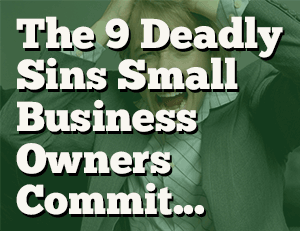How to sell online for small business
In today’s world, customers expect you to have some sort of online offering. Using the internet to shop around, read reviews and compare prices is natural to the modern-day consumer.
Small business owners need to know how to sell online. If you don’t have some form of presence, then you won’t be an option and you’ll miss out on a great opportunity. According to the Auspost eCommerce report, in 2018 online purchases in Australia grew by more 13% with 73% of households shopping online, spending over $27.5bn.
How to sell online in 4 steps
Setting yourself up doesn’t have to be a difficult task. To get started, create a light and simple website for your best-selling products and eventually, shift to selling most, if not all your products over time.
If you provide a service, then your setup might look a little different. Again, start with a light website, but instead of uploading products, think about creating a contact form. Ask potential customers questions that will allow you to gain a better understanding of their needs, in addition to their contact details, to generate enquiries for either yourself or your sales team to follow up.
Overall, learning how to sell online for small business owners is a fun but challenging process. To help you, we’ve listed four areas to think about before you take your business online.
Find an eCommerce website builder
The first area to get to grips with when learning how to sell online is finding an eCommerce builder – a browser-based software that lets you build an online store. With no need for any coding knowledge or advanced tech skills, you just need to select something that suits the requirements of your business.
For example, if you’re looking for something affordable and easy to use, the most popular tools are Wix and Shopify. They offer a range of payment options, making your store accessible to a larger group of potential customers. For a full list of eCommerce website builders, click here.
Ecommerce platforms
The second area to be aware of when learning how to sell online is finding a suitable marketplace. Selling your products using an eCommerce marketplace is very, very popular – Amazon is estimated to have over 2 million sellers. So, finding the best platform for you – among all the options – can be a challenge. Including eBay, Etsy, Facebook marketplace, and of course Amazon, small business owners can find choosing the right platform overwhelming. Overall, the most important element is to select a platform that aligns with your business.
For example, if you create handmade goods or sell vintage clothing, Etsy may be a great choice. Generally, shoppers go to Etsy looking for something unique and personal. Perhaps you specialise in high quality, recycled fashion, then the Facebook marketplace would be the way to go. Many people use it to look for discounted brands.
Typically, setting yourself up is simple:
- Create an account
- List a product for sale with a description, price, and image
- Set up a fulfilment method (how your product will be delivered)
- Accept payment from a customer
- Prepare the item to be shipped
But before you sign up to any platform, make sure you are aware of the associated costs such as transaction fees, listing fees, and if you sell abroad, currency conversion fees.
The other element to mention is the competitive nature of eCommerce marketplaces – they are crowded. So, perhaps the highest barrier to success is being noticed – this is where branding and marketing come in.
Brand
Branding is an essential part of learning how to sell online effectively. Creating a memorable brand helps consumers to trust you but also gives you the opportunity to stand out from the crowd. A brand is a company identity, an ethos, or a big brand idea. For example, our ethos is to provide simple, reliable accounting software to small business owners.
Ask yourself:
- Why did I start this business?
- What beliefs and values are important to us and our customers?
- Do we do something better than anyone else and how are we unique?
- What are the three words we would want our customers to use to describe us?
If executed successfully, a brand will give consumers a reason to purchase from your store beyond just the product itself. It is the connection between the business and the audience. To establish an ethos, follow these steps:
- Your audience – your brand should connect with your target audience. The perception of your brand to your target audience is an essential part of the consumer decision process. Ask yourself, what does our target market care about? And how can we identify with those desires in an authentic way?
- Brand tone and voice – establishing a brand requires a decided and consistent tone of voice. Will it be formal, informal, witty, professional, or playful? This tone of voice should be shown through all your marketing and at every touchpoint with a customer.
- Design – in eCommerce, the design is the strongest element to use to stand out. Design is the foundation of your brand identity. It is your logo, marketing collateral, web design, colour scheme, typography and the form and shape of individual elements.
Once you have these sorted, it will be much easier to set yourself apart from competitors. If you want your brand to have a positive perception, it’s crucial to create designs that accurately portray who you are to your customers.
Social media
Social media is the most accessible channel in the marketing handbook because it is affordable and has a large audience base. To start with, we recommend trying Facebook, Instagram, and Pinterest. Post content that you think your customer base will relate to without selling too much.
If you begin by posting sales messages and links to your products when you only have a few followers, people will instantly dislike your brand. Think about the way in which you choose who to like or follow. You’ll look at the ethos behind the organisation and if you relate to that ethos. Successful social pages build equity with their audience base before they begin selling.
As a small business owner, you probably will not have generated enough brand equity to sell on social media remember, people go to social for a break, not to be sold to.
So, to build brand equity, try authentic content about customer experiences, designed pictures of your products, and generally, create an experience that your customers resonate with. Check out Mr Foggs Tavern, Calpack, and Adelaide gin. They are all small businesses that have used social media to grow their business, meanwhile, they successfully appeal to their target market.
They sell a lifestyle. A lifestyle that their customers enjoy because of consuming their brand. It is a masterclass in crafting brand perception via social media. Above all, their styling, imagery, colours, and product placement provide a taste of the experience their customer base has with their offering.
Quick start: round up your existing customers
If you have an existing customer base invite them to like your page. By doing so, it will provide a foundation of people who can relate to your brand and help to kickstart your social journey. Also, once you have an established following, then you can start pushing sales messages, products, and promotions.
Time, effort, and consistency
Selling products online isn’t a get rich quick scheme because it takes time, effort, and financial investment. And, when it comes to marketing, consistency is key, both consistency of your brand and consistency in effort. Therefore, make sure to post daily on social media, write blogs each week, and regularly communicate with your customers.
Learning how to sell online is a long game. There is already a large market to service and that market is growing daily. So, find your niche (a how to blog here), understand your target market and then be consistent with your marketing efforts.











Leave a Reply